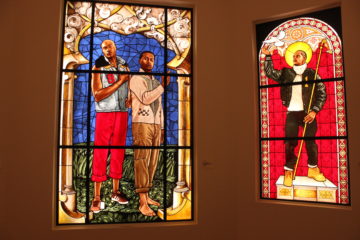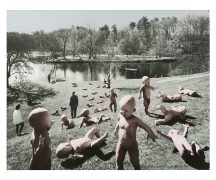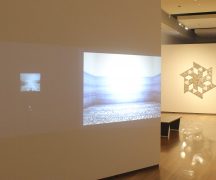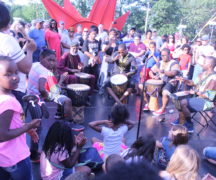By DAVID DUPONT
BG Independent News
Kehinde Wiley found his direction as a painter on a street in Harlem.
He’d recently finished his graduate studies in art at Yale and had enrolled the Studio Museum of Harlem’s art residency program in 2001.
At Yale he painted black males with extravagant hair styles. Thursday in a talk at the Toledo Museum of Art, he said that had completed his study “at the feet of the fathers,” and was in a crisis as to where to go next. There at his feet he found a piece of paper. A rap sheet. On it was the young man’s mug shot.

Kehinde Wiley speaks to the press
Wiley said at that instant he thought: “This is a really cool portrait. I know that’s kind of screwed up. If you’re thinking like I think which is to use your life to tell a story about the world you live in, finding this piece of paper tells a story about the world we live in.”
He turned the mug shot into a portrait, and that painting is now hanging in the Toledo Museum of Art’s exhibit Kehinde Wiley: A New Republic. The major retrospective of the Brooklyn-based artist’s career is now on exhibit through May 14.
In the 15 years since finding that mugshot Wiley has achieved “super star status,” said Brian Kennedy, director of the Toledo Museum. That was evident by the standing-room-only crowd that gathered in the Peristyle on Thursday to hear the artist’s talk on his work.
Wiley has achieved fame by both celebrating and challenging the notions of Western art. He has highlighted the lack of black bodies depicted in the paintings of museums such as the TMA. “That’s not right,” Kennedy said.
Wiley has set about redressing that by setting young people of color who he meets on the streets and dance halls around the world and placing them within the context of Western classic art.
So it is a black man wearing a bandana, sweat wristbands and camouflage who leads the army over the Alps, not Napoleon.
Through Wiley’s work black bodies command their place on museum walls in monumental form dressed in the best urban fashion.
Some of the women wear gowns designed by a top designer.
 All this came about because his mother sent Wiley and his twin brother to after-school art classes when they were 11. They lived in South Central Los Angeles and were coming of age in the late 1980s, the same time the Crips and the Bloods were emerging.
All this came about because his mother sent Wiley and his twin brother to after-school art classes when they were 11. They lived in South Central Los Angeles and were coming of age in the late 1980s, the same time the Crips and the Bloods were emerging.
“My mother put me through art school as a kid not because she particularly cared about the paintings on the wall but because she wanted to keep us off the street.”
The classes required two-hour treks across the city and back to the museum where they met kids from different neighborhoods who spoke different languages and ate different foods.
“The match got struck,” Wiley said, when he discovered “those portraits of 18th and 19th landed gentry at museum with all those powdered wigs, with lap dogs, all those pearls.”
“As a kid from the hood I thought: ‘What in the world is that?’” But he also thought: “I’d like to make something that contends on that level.”
“New Republic” is testament that he has achieved that goal.
While those old paintings were commissioned as celebrations of the subject’s wealth and status, Wiley finds his subjects through street casting. He approaches people on the street, Harlem at first, but now around the globe, and asks them to pose.
“At its core my work is getting into the street and finding people by chance,” he said. “But for the fact you were trying to get to the subway that day, you would not have been in my studio. But for that fact, you would not be on the walls of a great museum. …These are about complete chance.”
His own career has that element of chance. How else does a kid from South Central L.A. end up on the stage of the Peristyle in Northwest Ohio talking about his art before an admiring audience?
Not that celebrities and wealthy people don’t approach him about commissioning portraits. He always refuses. Well, almost always refuses. “When Michael Jackson called me, I had to take the call.”
The result was an equestrian portrait with Jackson, in a full suit of armor, sitting in for Philip II of Spain.
Wiley’s early work was devoted to portraits of young black men. He wanted to call into the question the violent, hypersexual image projected in the culture.
Only later did he turn his attention to women. His inspiration was the women who raised him. His complex view is seen in Bound, a six-foot tall, two-ton bronze sculpture of three identical female heads linked together by vine-like braids of thick hair.
His mother’s insistence on expanding her children’s horizons is felt in another way. When he was 12, she sent Wiley off to an art camp in what was then the Soviet Union. There he discovered Orthodox icons. His love of those sacred objects is reflected in his own icons, small enough to fit in his lap, in contrast to his usual “big, chest-beating paintings.”
He also explores sacred forms in his stain glass work, where the light captures and illuminates the dark skin of his subjects.
Wiley continues to seek inspiration around the world. In each setting, he puts the subjects in a particular context. In West Africa, his models are posed in ways inspired by the colonial sculptures in the city squares. The backgrounds use the pattern of the fabrics found in the markets of every village.
In Israel, the backgrounds of his portraits of Ethiopian Jews are drawn from an ancient paper-cutting. “It’s an amazing tradition that comes out of Judaism for thousands of years,” Wiley explained. “It’s portable. It’s the aesthetics of nomads. It’s the ability matter where you are or where you’re going to create something devotional and post it on your walls.”
Wiley brought this ancient beauty together with contemporary youth culture.
At the end of the question and answer period that followed the talk, Wiley conceded he’d been a little concerned about facing all these white Midwestern faces – though the audience was far more diverse in ethnicity and age than usual for such events.
“This is a tough time to give an artist talk,” he said. There is an aesthetic need in society. “It goes back to Mingus and Miles and grace and beauty and setting up a civilization. It’s about getting in balance, in rhythm. This shit’s off rhythm, and we need to get back into something call and response, amen, call and response, amen. Right now we can’t because we’re off our hopscotch.”
Earlier he had questioned the redemptive power of art, only to conclude that it had redeemed him.





